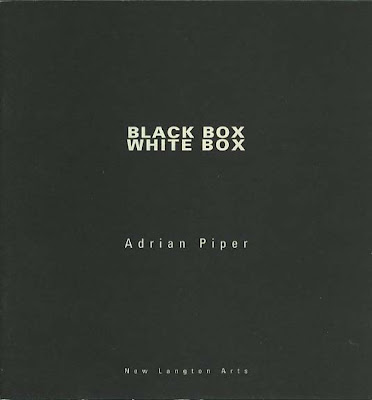From Ian Houston…
The idea of the political in art is at once inevitable and tedious. The risk of proselytizing, the banal, the tautological and the difficulties of a cynical audience familiar with many of the strategies of artistic expression can make for a tired experience. Adrian Piper‘s Black Box/ White Box [1993] skirts these problems through the simple process of providing an unavoidable confrontation with the facts of a brutal incident in an arena that reminds us of our complicity in the society that sanctioned it. Thus the politics of her statement are elevated beyond the demands of ideology and become instead an ethical confrontation mediated through this aesthetic experience we know as art.

Two box shaped rooms stand in the space of the exhibition. One black, the other white. You enter the white room through a short corridor. To your left is a comfortable chair. If you sit in the chair, you will see on the screen in front of you a looped video of the incident of March 3rd 1991 in which Rodney King was beaten by eight members of the LAPD. The footage is hypnotic, fascinating. The violence sickening. To be confronted with it in the extreme austerity of this simple white room compounds its violence. In the background the Marvin Gaye song What’s Going On plays under excerpts from a speech made by George Bush Snr in which he promises to provide more state troopers to deal with the riots provoked by the acquittal of the officers from the charges they faced for this assault. Beside you is a box of tissues.
A short distance away is the black room. Its dimensions and structure are equivalent to the white room though the ambience is, needless to say, darker. You sit in a chair. In front of you is a backlit, mirrored portrait of Rodney King after his beating. His face is swollen and badly cut. A tape recording of Rodney King’s statement to the rioters plays on a thirty second loop. He pleads for the violence to stop, exhorting everyone to “get along.” When the statement finishes, the light behind the mirror is extinguished and a spotlight focused on the viewer’s chair, lights your face so that you can see yourself in the mirrored portrait. On the wall directly behind you is a framed picture of George Bush snr shaking hands with the LAPD officers after their acquittal.
Adrian Piper is an Afro American Professor of Philosophy whose field is Ethics. Her position on this event is evident. The explicit manner in which she addresses this subject seems motivated by a simple question. How can people act in this manner? There is a clinical rage at work that has distilled each element of the drama and positioned them in a relation that allows the audience not only to apprehend the inherent racism of the society but sense our complicity, that we have let such a clear instance of injustice become nothing but a media mediated memory rather than a powerfully motivating event for change. To remind us that nothing has changed to stop such an event occurring again. So the power of this work lies, not in inference, connotation and subtext but in the direct confrontation with the facts of an incident. With the unalloyed horror of a man coming to grief at the hands of a much greater force with no channels for the seeking of redress and justice. I found it to be one of the most powerful and moving works at this year’s Biennale.
Adrian Piper’s Black Box/ White Box is installed at the Art gallery of NSW for the 2008 Sydney Biennale.
